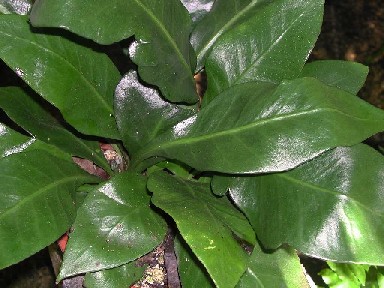|
Microsorum
whiteheadii

Microsorum whiteheadii Smith
& Hoshizaki
Even today in the early part
of the 21st century new ferns are still being discovered. This member of the
Polypodiaceae
was discovered in the Bukit Tingii area of Western Sumatra.
This fern grows on limestone outcroppings.
A group of collectors were out
in search of Amorphophallus hirsutus
when they happened upon a limestone outcropping
which was home to several of
these ferns. At the time of discovery, the ferns were desiccated due to
the lingering drought
that summer in Indonesia. After the plants were
gathered up and rehydrated. They began to look healthy again.
This fern was originally seen
by John Banta, a Florida plantsman, who could not recall where he had originally
collected it.
It was later found by Reggie Whitehead who collected
herbarium samples and worked to get the plant identified. The
taxonomic
work was performed by Alan R. Smith and Barbara Joe Hoshizaki.
Strap ferns
This is an example of what is
known as a strap fern. The strap ferns are primarily in the genera of
Polypodium (this includes subcategories such as Campyloneurum, Niphidium, and
Microsorum) and Pyrrosia.
There are similarities in
these strap ferns, but they all are broad and lanceolate in shape. The
neo-tropics include
Campyloneurum phyllitidis and C. latum which are native to
South Florida, and to the untrained eye, these two ferns can
look almost
identical. Niphidium crassifolium takes on a similar appearance, but there
are significant differences once you
observe the sori.
Old world species are
represented by Microsorum. In Southeast Asia, there is Microsorum
fortunei, M. thailandicum, M. steerii, and M. punctatum, plus the new
species, M. whiteheadii. In Africa, there is M. pappei (which is very similar to
M. fortunei in appearance). There are other Microsorum species in
these countries, but they are generally not cultivated.
Within the genus Pyrrosia,
there are several strap-fronds: Pyrrosia stigmosa, P. splendens, P.
beddomeana, P. penangiana
and P. princeps. These fronds tend to grow to an
average length of perhaps 2 1/2 feet.
Outcroppings
The original outcropping of this plant has probably been destroyed. The
outcropping was
being torn down on the day that this fern was collected.
The limestone outcroppings are a
source of marble, and so, any vegetation on the
rocks are summarily destroyed when
workers are extracting marble. In the
same area, there was another outcropping which was reduced to rubble.
This
area is (or was) home to Amorphophallus hirsutus.
| 